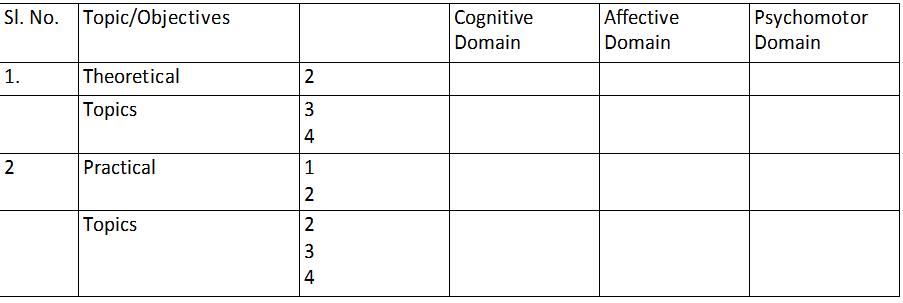Dr. V.K. Maheshwari, Former Principal
K.L.D.A.V(P.G) College, Roorkee, India
The aim of higher learning is to develop the capacity to respect the ideas and feelings of others; healthy criticism, appreciation, and present own ideas and seek clarification. The learner should be able to present his own views on the theme. His potentialities can only be developed by employing higher technique of teaching and instruction at higher level. A workshop is one of the main techniques used for higher learning.
There are significant differences in the teaching methodologies employed by educators in various disciplines. This method relies heavily on the involvement of the learner in formulating or constructing knowledge through hands-on, small-group and individual explorations, using concrete objects or technology.
Teaching method is defined as a learning outcome oriented set of activities to be performed by learners and learning supporters. Teaching methods are related to learning patterns, learning designs, and pedagogical scenarios, which represent similar concepts that other projects are working on. Within teaching methods, proven approaches/ techniques to teaching are captured so that other educators may (re)use these successful approaches in their own teaching. Teaching method is the set of elements that are external to and give meaning to a teaching pedagogy. For instance, subject domain or target groups are elements of the teaching method context.
The workshop explicitly focuses on the context because the successful implementation of generically described teaching methods in units of learning heavily depends on the context
Workshop is defined as assembled group of ten to twenty five persons who share a common interest or problem. They meet together to improve their individual skill of a subject through intensive study, research, practice and discussion
Teaching is a continuum from conditioning to indoctrination and training is also inclusive in it. The new innovations and practices of education are introduced by organizing workshop in which persons are trained to use new practices in their teaching learning process. The workshops are organized to develop the psychomotor aspects of the learner regarding practices of new innovations in area of education. Participants are expected to do some practical work to produce instructional teaching and testing material.
The term workshop has been borrowed from engineering… In these workshops persons have to do some task with their hand to produce something. Question Bank Workshops are organized in education to prepare questions on the subject. The designers are given knowledge and training for preparing questions in the workshop.
Objectives of Workshop
Cognitive Objectives.
The workshop is organized to achieve the following cognitive objectives:
(i) To solve the problem in teaching profession.
(ii) To provide the philosophical and sociological background for instructional and teaching situation.
(iii) To identify the educational objectives in the present context.
(iv) To develop an understanding regarding the use of a theme and problem.
Psychomotor Objectives.
The following objectives are achieved by this method under psychomotor domain:
(i) To develop the proficiency for planning and organizing teaching and instructional activities.
(ii) To develop the skills to perform a task independently.
(iii) To determine and use of teaching strategies effectively.
(iv) To train the persons for using different approaches of teaching.
Generally objective related with Affective domain are not supposed to be achieved through Work shop.
Functions of workshop
The workshop takes a closer look at the factors that influence the successful adaptation of teaching technique to create specific learning arrangements. The “context” created by the specific learning situation is seen as the defining influence of teaching method selection and adaptation. Workshop participants will use generically described teaching method for (supposed) application to a specific learning/teaching situation. The workshop will look at the triangle built by the three concepts teaching method, unit of learning, and context with the goal to determine the relevant elements that influence the (successful) adaptation of teaching methods to a specific context in order to create a unit of learning that is targeted towards a specific implementation. The workshop’s goal is to work out a practitioner-oriented set of elements that make up the context of teaching methods as well as the barriers and uncertainties that arise when using generic teaching methods.
1. The workshop method is used to seek, explore and identify the solutions to a problem; to permit the extensive study of a situation, its background and its social and philosophical implications.
2. It is used for teachers for giving awareness and training of new practices and innovation in Education.
3. It provides an opportunity to prepare specific professional, vocational or community, service functions. A high degree of individual participation is encouraged. It permits group determination of goal and method.
Procedure of Workshop Method
There’s no doubt that planning a workshop is a lot of work. But if enough time is spent in thinking through the details, everyone will get full value from the event.
The workshop will mainly incorporate interactive elements. To kick-off the workshop, the organizers will shortly outline the strengths and weaknesses of generic teaching method descriptions, and show the importance of providing context information to facilitate real implementation. After the introduction, the participants will split up into groups and take an example generic teaching method, which they will exemplarily adapt to a supposed teaching context. While going through this process, the participants will identify and record context elements that they find relevant as well as questions that arise. Each group will agree among the group members what context elements represent the core when adapting teaching methods.
The workshop’s goal should be at the center of all planning. Creative exercises will get everyone relaxed and involved, and don’t forget to follow up afterward: Although it can be scary to hear what people really thought of all the hard work, it’s the only way to improve the future event.
The organization of the workshop can be divided in two phases;
Pre- active phase and Active phase.
The Pre-active phase
Follow these steps to make workshop a valuable experience:
Step 1: Define the Goals
Every workshop must have a goal. Many workshops are a waste of time because there’s no clear goal kept at the center of the discussion. Without the clear goal, there’s really no point in getting people together.
Step 2: Decide the Target Group
Knowing who will participate directly relates to the objective .Make a list of people who needs to be there. Try to be as specific as possible, but leave a few openings for last-minute additions.
The target audience for the workshop includes instructors and instructional designers interested in the application of proven teaching methods, learning patterns, or pedagogical scenarios. The target group benefits from this workshop by gaining experience in exemplary transferring a generic teaching method to a unit of learning, and by identifying what relevant context elements reinforce this process. The participants’ awareness of needed elements is thus sharpened and ability to use generic teaching methods in future applications is enhanced. Furthermore, participants will support the scientific understanding of the context of teaching methods through the contribution of their own teaching and learning design experience. Participants are expected to contribute actively to the workshop. Participants do not have to write an article for this workshop. It is expected that workshop participants contribute actively to the workshop’s discussions and tasks.
Step 3: Select the Right Location
Think about the logistics and practical details of the workshop for the selection of the location. Make sure that everyone be able to see the visual aids. If a certain technology, like teleconferencing is used, see will the location support it? Also make sure about the appropriate facilities for breakout sessions. Will everyone be able to reach the venue? Will there is a need to organize accommodation for people who are coming from a long way away? And what catering facilities does the venue provide?
Step 4: Prepare an Agenda
As the primary objective is decided and who will participate is confirmed, start to develop an outline of how to achieve the workshop’s goal.
- Main points – Create a list of main points to discuss, and then break down each larger point into details
- Visual aids – List the visual aids, if any, to be used for each point. If need technical support provide expert help, this helps the people to determine where they need to focus their efforts.
- Discussions and activities – Take time to list exactly which group discussions and activities will be used at which point, in the workshop. How much time will be allowed for each exercise? Make sure the activities are appropriate for the size of the group, and ensure that the venue has the resources (for example, seminar rooms) needed to run sessions.
Remember, the more detailed the plan be, more the workshop will run to schedule – and be successful.
Step 5: Develop a Follow-up Plan
The only way to find out if the workshop was a success is to have an effective follow-up plan. Create a questionnaire to give to all participants at the end of the event, and give them plenty of opportunity to share their opinions on how well it went. It’s the only way to learn – and improve – for the next time.
It’s also important to have a plan to communicate the decisions that were reached during the workshop. Plan to send out a mass email to everyone with the details. Plan to put it on your college internet. People need to know that their hard work actually resulted in a decision or action, so plan to keep them informed about what’s happening after the workshop has ended.
The Active phase
Generally workshops are organized for three to ten days. In special cases the period of workshop may be extended. It depends on the nature of task assigned to the workshop participants. It can be organized in three stages:
First Stage.
Presentation of the theme for providing awareness. resource persons or experts are invited to provide the awareness and understanding of the topic. Paper reading is done to discuss the different aspects of the theme. The trainees or participants are given opportunities to seek clarification. The experts provide the suitable illustration and steps for using it in classroom teaching or education. . In the first stage theoretical background is provided to the participants.
Second stage.
Practice the method for its applicability. In the second stage the group is divided into small groups e.g., a workshop for lesson planning or writing objectives in behavioral term or a Question Bank workshop. The groups are formed on the basis of subjects (Language, Science, Math’s, Social Studies). A resource person or expert is assigned to provide the guidance for the work to be performed. The expert provides guidance and supervises the work of each trainee of his group. Every participant has to work individually and independently. Every trainee has to complete has task within the given period. At the end they meet in their groups and discuss and present their task to be completed.
Third Stage.
At the round-up of the workshop A representative of each group will then be asked to present the findings. Following all groups’ presentations, workshop participants discuss the findings, conceivably adding or eliminating elements. The result of this first phase will be an unordered set of context elements accumulated from all workshop groups as well as questions that remain unresolved.
In a second stage, the participants are required to elaborate a meaningful ordering scheme for the thus far collected context elements. This is achieved by illustrating an example for each context element that is derived from teaching practice. The groups then prioritize the context elements, assigning, for instance, first and second priorities based on teaching requirements. The groups will also each choose one of the unresolved questions, which they will discuss in further detail. This discussion serves to either provide a solution to the question, or to provide a more detailed description of what makes up the problem. Outcomes of this group work are again presented to the workshop auditorium. Comparative discussion can take place to arrive at a final result for the context elements of teaching methods.
The round-up will be a reflective discussion with all workshop participants, where the experience of using teaching methods is put into personal perspective, e.g. what value participants see in the use of teaching methods, or what elements regarding the context cause uncertainties with participants.
Evaluate the material prepared by the participants as follow up. As this groups meet at one place and present their reports of work done at second stage. The participants are given opportunists to comment and give suggestions of different aspects of the reports; Formalities are observed at the end of the workshop.
Follow up:
A follow up is an important part of a good workshop. The effectiveness of a workshop is ascertained by an objective follow up. The trainees are asked to continue their task and examine its work ability and usability in their institutions. Participants will take away from the workshop a set of structured teaching methods for use in their own teaching, as well as the ability to adapt a teaching method to their teaching context. This includes a refined understanding and awareness of the elements that play a defining role when performing this task.
The workshop will provide a set of practitioner-defined context elements for generic teaching methods that are prioritized and illustrated in examples. Last but not least, problems of generic teaching method use are collected. These inputs will be used to further refine the research on optimizing the provision and use of teaching methods.
The participants are invited to meet again and present their institutions feedback. The participants are invited to meet again and present their experiences regarding applicability of the topic or new practices. They may give some practical suggestion in this context. A report of the workshop is prepared.
Suggested Areas of Education for Workshop Method
- New format of lesson planning.
- Writing objective in behavioral terms.
- Preparing objective type tests which are objective centered.
- Action research projects for classroom problems.
- Preparing instructional material or teaching model.
- Workshop on Micro teaching.
- Workshop on Interaction analysis technique.
- Workshop on test construction.
- Workshop on preparing research synopsis or proposals.
- Workshop on non formal education.
- Workshop on designing course for teacher education.
Roles in Workshop Method
Role of Organizer of the Workshop Technique. The program and schedule is prepared by the organizer. He has to arrange for boarding and lodging facilities for participants as well as for the experts.
Role of Convener in First Stage. At first stage of the workshop, the theoretical aspects are discussed by the experts on the theme of the workshop. Therefore, a convener is nominated or invited who is well acquaint with the theme or the workshop. He has to conduct workshop at this stage and he has to observe the formalities and key note of the workshop.
Role of Experts or Resource persons. In organizing a workshop, resources persons play an important role in providing theoretical and practical aspects of the theme. They provide guidance to participants at every stage and train them to perform the task effectively
Role of Participants or Trainees. The participants should be keen or interested in the theme of the workshop. At the first stage, they have to acquire understanding of the theme. At second stage, they have to practice and perform the task with great interest and seek proper guidance from the experts. They should try to carry the concept to their classroom to evaluate its workability in actual situation. They effectiveness of any workshop technique depends upon the involvement of the participants in the task.
Overall Workshop Tips-
Here are some more ideas for running a successful workshop
- Ø Getting everyone involved is the key to a successful workshop. If one stands up and talks for three hours, he is just giving a lecture – not facilitating a workshop. Everyone needs to participate
- Ø Many people are nervous about speaking up in an unfamiliar group. Plan group exercises; keep the size of each group small, so people are more comfortable in talking and interacting.
- Ø Determine how to record the ideas from each group.
- Ø Remember; spend as much time as possible in creating fun and interest in group exercises. These will likely keep everyone interested and participating.
- Ø Start the meeting with a few icebreakers to get everyone relaxed and comfortable.
- Ø If the workshop’s goal is to address a difficult or sensitive topic, It is especially important to get the group comfortable before starting. One way is to tell a story that’s loosely related to the topic before beginning discussion on the difficult issue.
- Ø Sometimes, not everyone has to stay for the entire workshop… Identify which sections the busiest participants need to attend, and suggest in advance when they might want to arrive and leave. They’ll appreciate this consideration.
- Ø Where possible, avoid holding the workshop after lunch, between 2:00 and 3:00 in the afternoon. For many people, this is their slowest, most unproductive time of day. The group will probably be more energetic if schedule the event in the morning or late afternoon. (If the workshop in the early afternoon makes sure there’s plenty of strong coffee is available)
Advantages of Workshop Method
- It can be use to realize the higher cognitive and psychomotor objectives. The workshop method enables the learner to explore or master relatively abstract ideas by first encountering them in concrete, physical embodiments, then as pictorial representations, and finally in symbolic (letter, number, sentence) form…
- It can be effectively used for developing understanding and proficiency for the approaches and practices in education. It is used for developing and improving professional efficiency. The teaching proficiency can be developed by using it.
- It provides the opportunities and situations to develop the individual capacities of a teacher.
- .The workshop method enables instructors to function as the “guide on the side,” rather than as a “sage on the stage.” Those using the workshop method do not focus on telling students information. Instead, they essentially create learning experiences that guide, direct, and facilitate the acquisition of new knowledge by the learner
- It develops the feeling cooperation and group work or team work. . The workshop method helps the instructor create an environment in which the learner is more likely to be involved and motivated. The workshop method focuses on participatory, hands-on learning; small-group activity and problem solving; pair and small-group discussions; etc. As a result, because of the “active” rather than “passive” nature of the experience, larger numbers of learners are motivated to participate and learn.
- It provides the situation to study the vocational problems.
- It introduces new practices and innovations in Education.
Limitations of Workshop Method
- Workshops in education are usually seminar cum workshop on any theme of problem.
- The teachers do not take interest to understand and use the new practices in their classrooms.
- The workshop cannot be organized for large group so that large number of persons is not trained.
- Participants do not take interest in practical work or to do something in productive form.
- Generally follow up are not organized in workshop technique.
- It requires a lot of time for participant and staff.
- A large number of staff members are needed to handle participation.
- It demands special facilities or materials.












